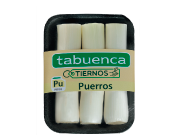LEEK |
|
There is no scientific information certifying the true origin of this plant, as it has never been found in the wild. Nevertheless, it is believed that the leek comes from the Celts, 3,000 or 4,000 years B.C.. Its name was determined as eastern garlic and was used for stews and for medicinal uses.. During the Middle Ages, its consumption spread through Europe, and from there to the rest of the world, and was largely used to ease starvation and relieve the plague and epidemics that blighted Europe in that period. There are two types of leek, the industry and market leek, differentiated by the colour of their leaves and the length of the shaft. The market leek usually has leaves of a bluer colour and shorter shaft, while the industry leek has a longer shaft and light green leaves. The varieties most used by the market are: Romil Atal, Selecta Elina and Revil. For industry they are: Kamusff, Bulgina and the long Bulgaria leek. It is a vegetable that contains small amounts of fat, between 2 and 3% protein and 7% carbohydrate. This vegetable is recommended for its high percentage of mineral salts such as phosphorus, calcium and potassium. The consumption of leek is very advisable for rheumatism, anaemia and as a purifier for blood. It is used as a condiment for many dishes due to its pleasant flavour and for consumption its lower section is usually used, corresponding to the bulb and leaves. |
Packaging
 |
 |
| Fresh | Fresh Packaged |
Related Products
 |
 |
| Tender Leek | Organic Leek |
LEEK
There is no scientific information certifying the true origin of this plant, as it has never been found in the wild. Nevertheless, it is believed that the leek comes from the Celts, 3,000 or 4,000 years B.C..
Its name was determined as eastern garlic and was used for stews and for medicinal uses.. During the Middle Ages, its consumption spread through Europe, and from there to the rest of the world, and was largely used to ease starvation and relieve the plague and epidemics that blighted Europe in that period.
There are two types of leek, the industry and market leek, differentiated by the colour of their leaves and the length of the shaft. The market leek usually has leaves of a bluer colour and shorter shaft, while the industry leek has a longer shaft and light green leaves. The varieties most used by the market are: Romil Atal, Selecta Elina and Revil. For industry they are: Kamusff, Bulgina and the long Bulgaria leek.
It is a vegetable that contains small amounts of fat, between 2 and 3% protein and 7% carbohydrate. This vegetable is recommended for its high percentage of mineral salts such as phosphorus, calcium and potassium.
The consumption of leek is very advisable for rheumatism, anaemia and as a purifier for blood. It is used as a condiment for many dishes due to its pleasant flavour and for consumption its lower section is usually used, corresponding to the bulb and leaves.
Packaging
-

Fresh -

Fresh Packaged
Related Products











